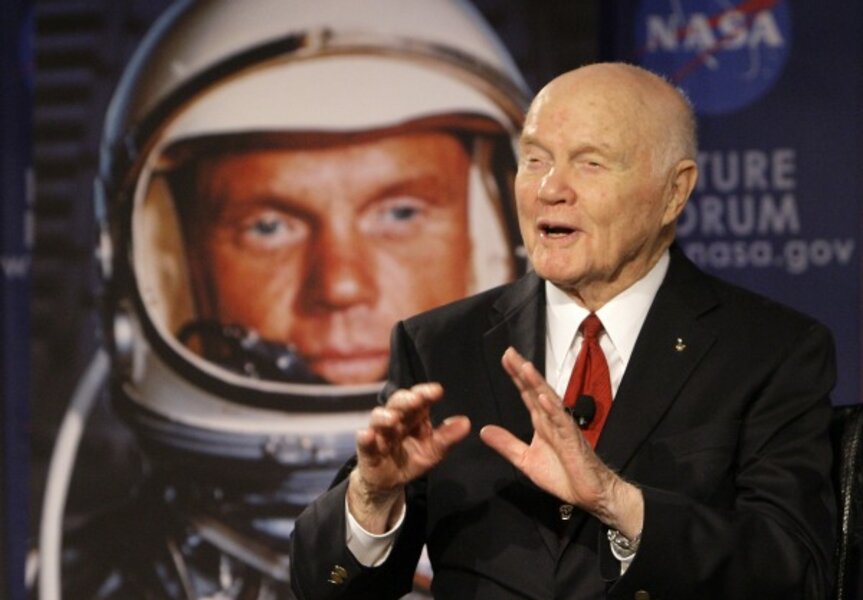John Glenn and Earth orbit anniversary: America needs manned flight in space
| Washington
Fifty years ago this week, on February 20, 1962, John Glenn Jr. became the first American to orbit the Earth, inspiring generations of citizens and setting the nation’s human space flight program on a path to a successful moon landing a mere seven years later.
As ranking member of the House Committee on Science, Space, and Technology, I recently had the opportunity to participate in the Congressional Gold Medal ceremony honoring Mr. Glenn, who is also a former senator. Joining him as recipients of congressional medals were Neil Armstrong, Michael Collins, and Edwin “Buzz” Aldrin Jr., the crew of the first mission to land on the moon back in 1969.
Each of these individuals is a genuine national hero and worthy of our gratitude. They and the astronauts that preceded and followed them were willing to put their lives at risk – and sometimes make the ultimate sacrifice – in order to push back the frontiers of knowledge and help our country achieve preeminence in space exploration.
Yet, America’s human space flight program – scaled back since the final space shuttle launch last July – has always been about much more than simply building rockets and space capsules and launching astronauts into space.
It is about inspiring people; it is about providing a peaceful and positive demonstration to nations around the world of American technological preeminence; it is about developing cutting edge technologies for human space missions that benefit our citizens and create new jobs.
It also motivates young people to pursue careers in science and engineering and advances knowledge generally.
The list of the fruits of investments in NASA that have become embedded in daily life is practically endless, whether they be as broad in scope as global satellite communications or as specific as smoke detectors, cordless power tools, digital mammography, body imaging, specialized formula for infants, and firefighter breathing systems. The Apollo and shuttle programs alone resulted in over 200 commercialized applications.
I know that some say: “The space race is over, we won it more than 40 years ago, and supporters of human space exploration are just captive to nostalgia.”
I disagree. We are in a new, equally demanding “space race” – a race to inspire young people to acquire the science and engineering skills they will need to compete for the jobs of the future; a race to develop the technologies that will not only help Americans explore space but also strengthen our economy and improve quality of life back here on Earth; and a race to maintain our leadership as a space-faring nation in the face of growing competitive challenges by other nations.
During a hearing before our committee last fall, Mr. Armstrong testified that by not continuing manned space flight, America jeopardizes its future science, technology, engineering, and math (STEM) workforce, and I couldn’t agree more.
“A substantial current and long range threat is, and will be, the downward trend in engineering degrees granted in this country and the substantial increase in such graduates in other parts of the world,” said Mr. Armstrong.
He continued, “Public policy must be guided by the recognition that we live in a technology driven world where progress is rapid and unstoppable. Our choices are to lead, to try to keep up, or to get out of the way. A lead, however earnestly and expensively won, once lost, is nearly impossible to gain.”
There are also those who say: “It’s time to get the government out of space exploration – let the private sector do it.” Such a statement ignores the fact that the US human space flight program – and NASA in total – represents one of the most effective public-private partnerships in pursuit of challenging goals that this country has ever seen.
The facts are clear – almost 85 percent of NASA’s budget already goes to the private sector to provide the hardware, software, intellectual energy, and services that help NASA push back the space frontier.
Finally, there are those who say: “Times are tough. We can’t afford manned space flight right now.”
We can’t afford not to pursue a meaningful human space flight program. The amount of funding that would be saved if we would walk away from NASA’s human exploration program would have no significant positive impact on federal finances, but it would result in the loss of tens of thousands of good-paying, skilled jobs in the aerospace sector; would slow the development of advanced technologies that could wind up creating new jobs in the future; would forfeit American leadership in space; and would inevitably lead some of the best and brightest young minds to turn away from studying science and engineering.
In this week of celebrating John Glenn’s historic orbital flight, we would do well to ponder a statement that Eugene Cernan – the last man to date to walk on the moon – made when he testified at the same hearing as Armstrong:
“The space program has never been an entitlement, it’s an investment in technology, jobs, international respect, and geopolitical leadership, and perhaps most importantly in the inspiration and education of our youth.
“Now is the time to be bold, innovative, and wise in how we invest in the future of America. Now is the time to reestablish our nation’s commitment to excellence. It is not about space – it’s about the country.”
I could not agree more.
Rep. Eddie Bernice Johnson, Democrat of Texas, is the ranking member of the House Committee on Science, Space, and Technology.






